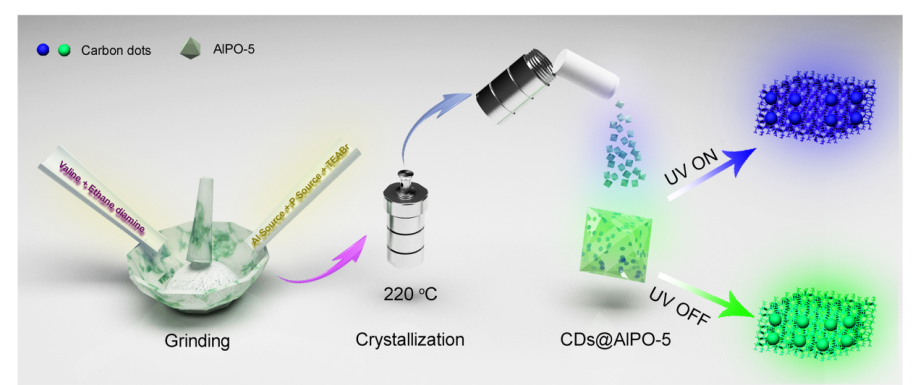Hongyue Zhang, Kaikai Liu, Jiancong Liu, Bolun Wang, Chengyu Li, Wei Song, Jiyang Li*, Ling Huang and Jihong Yu*.
CCS Chem. 2020, 2, 118–127. Published 26 February 2020
Organic afterglow materials are highly desirable for optoelectronic applications, but they usually suffer from complex preparation process, low quantum efficiency, and short lifetime due to the ultrafast deactivation of the highly active excited states involved. In this work, the authors succeeded in achieving solventfree thermal syntheses of high-efficiency afterglow CDs@zeolite composite materials by simply grinding the solid raw materials of zeolite and precursor CDs at room temperature, followed by thermal crystallization. This method afforded maximum embedding of CDs into growing zeolite crystals, as well as strong host–guest interaction to surpass the nonradiative transition of CDs, thus producing composite materials with ultralong dual emission of thermally activated delayed fluorescence and room temperature phosphorescence with a record high lifetime of 1.7 and 2.1 s, respectively, and the quantum yield of 90.7%. Furthermore, in a preliminary experiment, the authors applied the composite materials in alternatingcurrent light-emitting diode supplementary lighting, which exhibited a promising potential in optoelectronic applications.

Schematic representation of confinement synthesis of CDs in AlPO-5 zeolite
This paper reports a remarkable cooperative effort among 5 laboratories. Prof. Jihong Yu and Prof. Jiyang Li from Jilin University are the corresponding authors of the paper. Hongyue Zhang from State Key Laboratory of Inorganic Synthesis and Preparative Chemistry and International Center of Future Science in Jilin University is the first author of this work. Other co-authors include Dr. Kaikai Liu, Dr. Jiancong Liu and Bolun Wang from Jilin University, Prof. Chengyu Li from Changchun Institute of Applied Chemistry, Prof. Wei Song from Key Laboratory of Supramolecular Structure and Materials Jilin University, and Prof. Ling Huang from Institute of Advanced Materials (IAM), Nanjing Tech University.
Read more at CCS Chemistry:
https://www.chinesechemsoc.org/doi/10.31635/ccschem.020.201900099